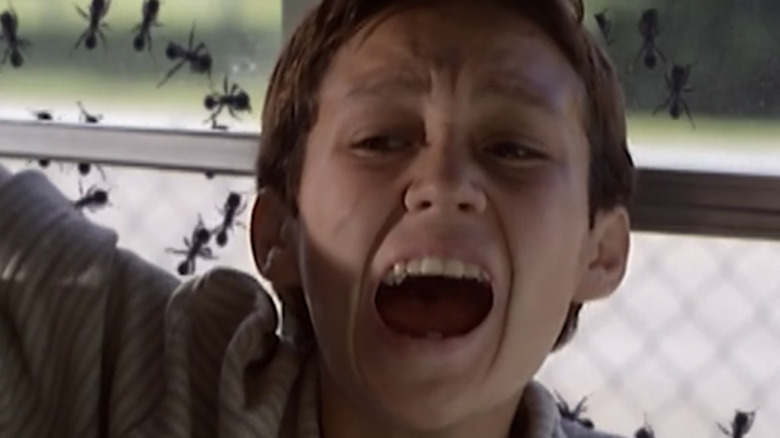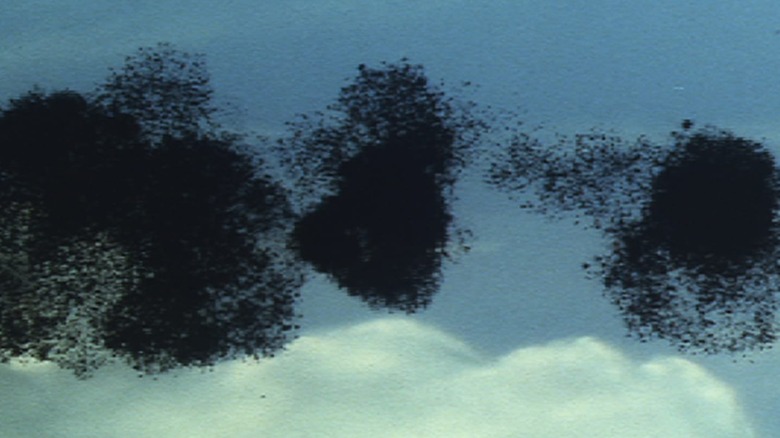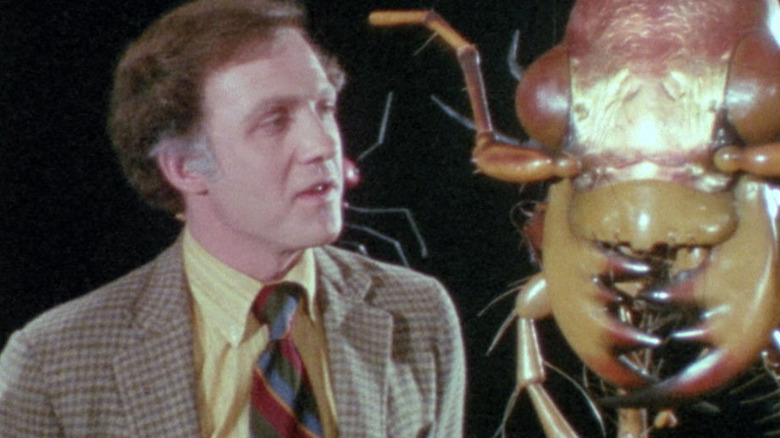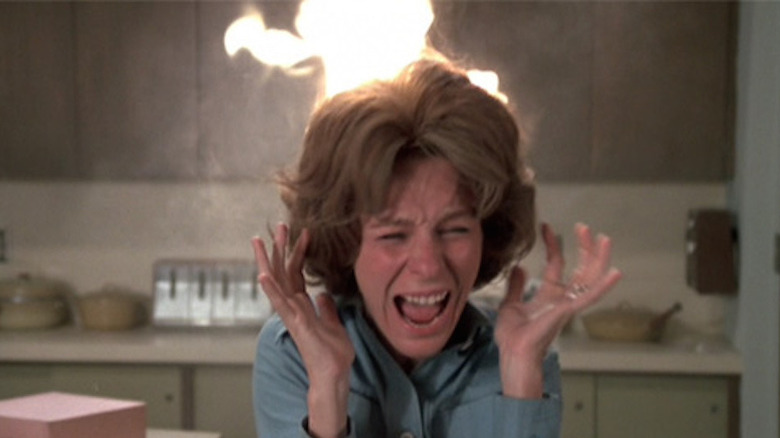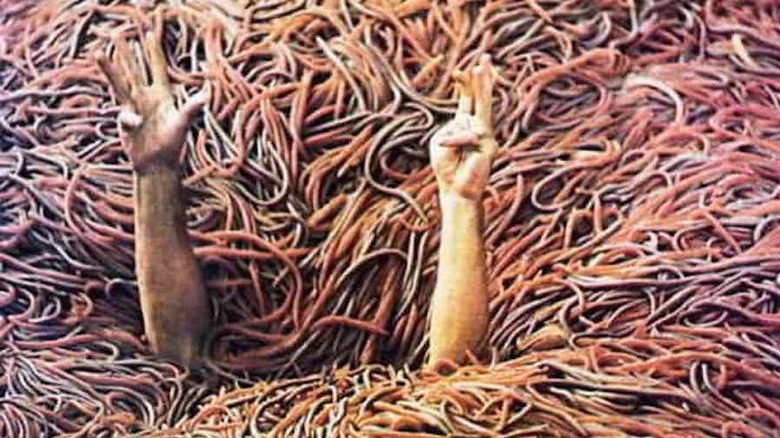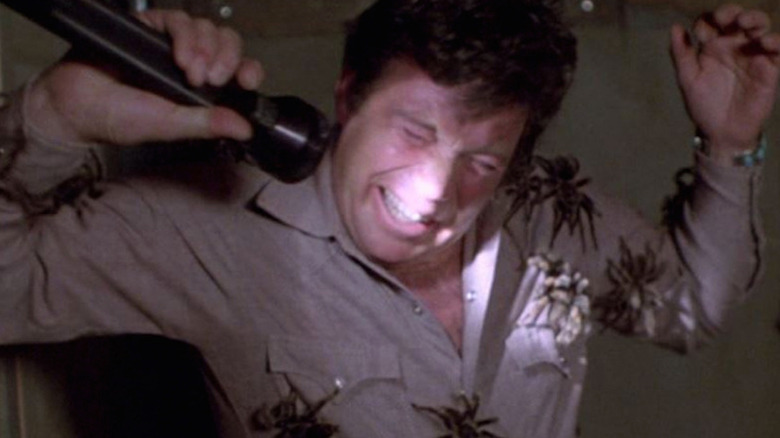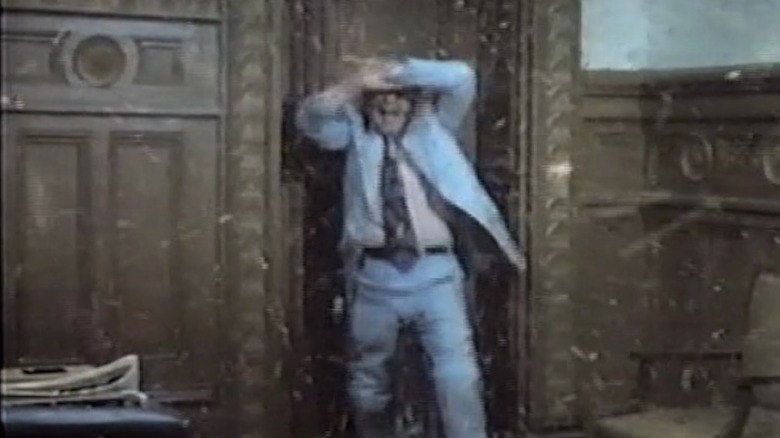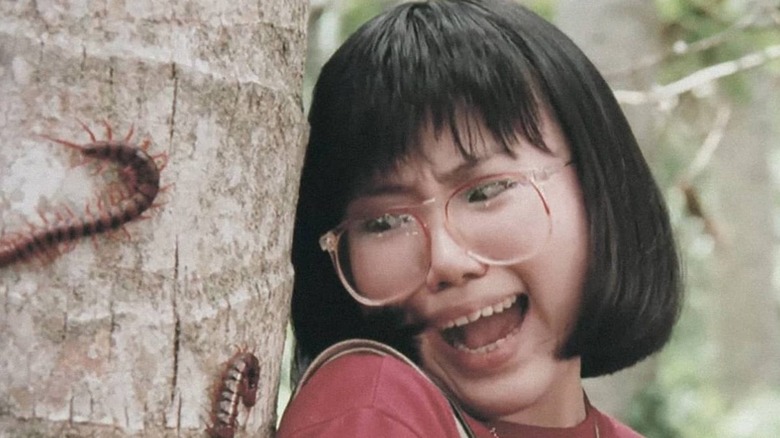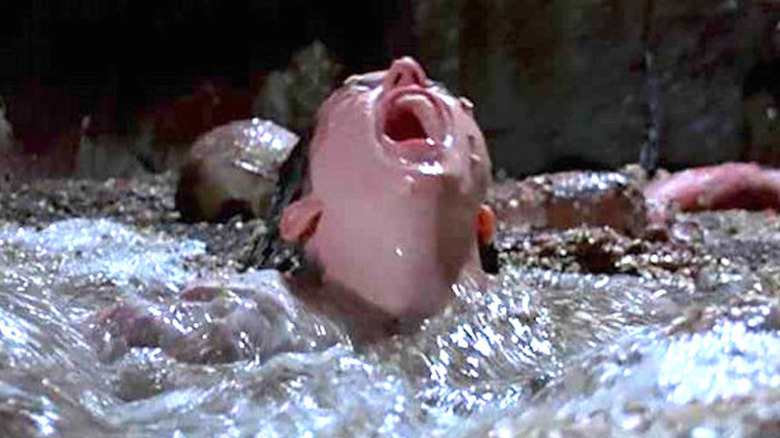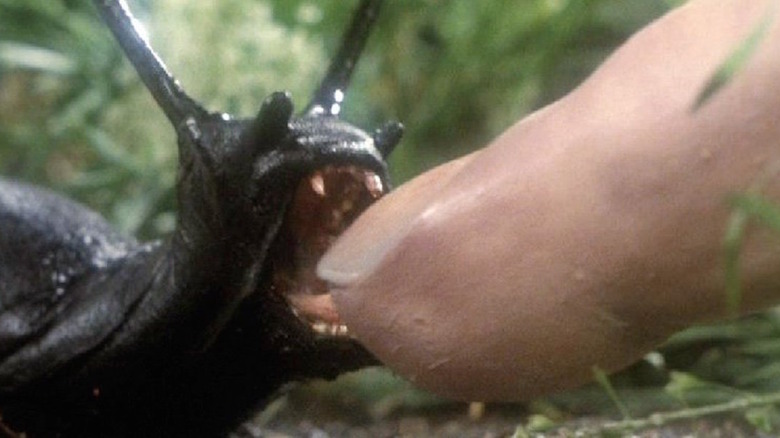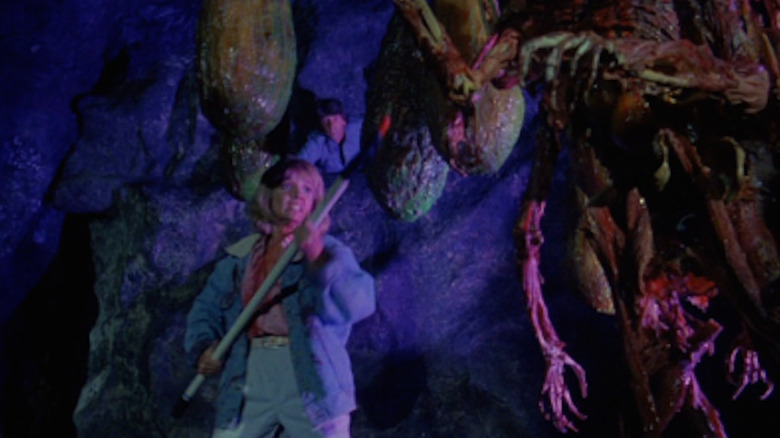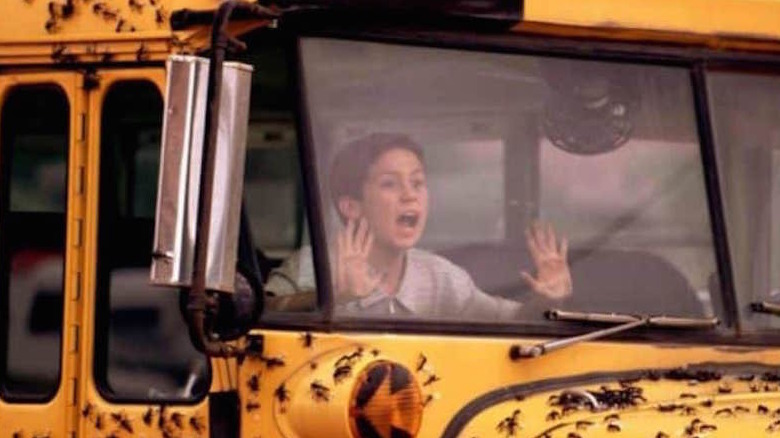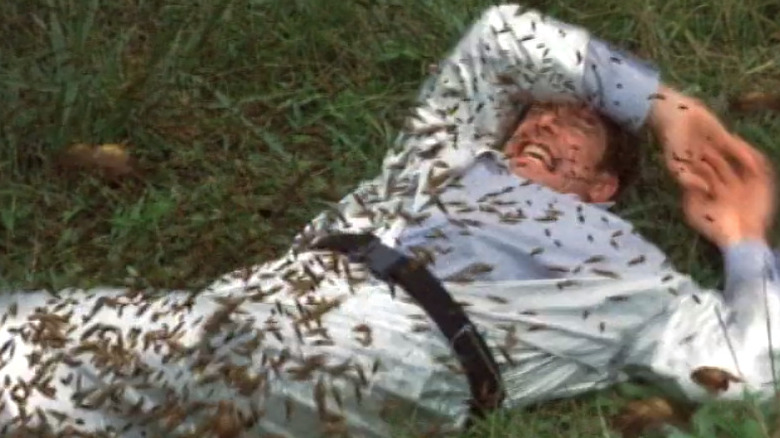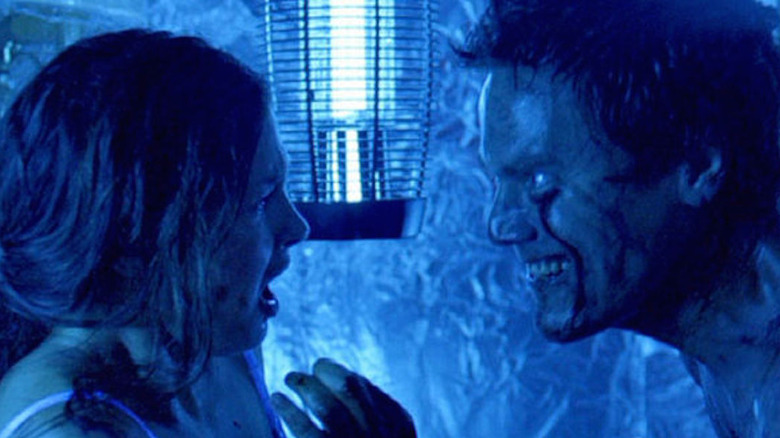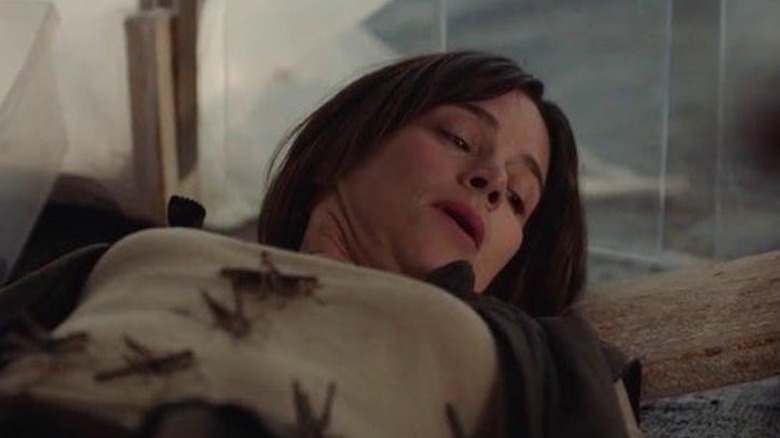The Most Bizarre Horror And Sci-Fi Movies About Insects From Around The World
When it comes to insects in horror and science fiction, we all know the king-sized variety: the oversized ants in "Them!", the monster-god Mothra in Toho's Godzilla series, and the invading "Bugs" in "Starship Troopers" come to mind, as do any number of '50s-era "big bugs" featured in "Tarantula," "The Deadly Mantis," and so on. Somewhat lesser known are the horror and sci-fi features built around normal-sized insects — the sort you might see around you every day.
While their size may not be imposing, insects have enough offensive and defensive capabilities to give humans the creeps: mosquitos and ticks can drink our blood and pass on infectious diseases, ants and termites can infiltrate and even destabilize our homes, and locusts can consume crucial supplies of food. Let's not even get started on spiders.
That sort of menace is the stuff of great horror and science fiction, though the big bugs seem to earn more screen time (see "The Fly," "Mimic," etc.) than the down-to-earth variety. Their screen adventures also tend towards more unusual territory: either off-kilter ideas or out-to-lunch conception. Below is a (spoiler-heavy) list of some of those bizarre horror and sci-fi titles, top-billed by the creeping, crawling, and flying insects we see every day, as well as a few very odd exceptions.
Insects bring on the apocalypse in Japan's Genocide
Unlike many of its competitors in the Japanese film industry during the 1960s — Toho, Toei, and Daiei, among others — the venerable Shochiku Company stayed far afield of horror, fantasy, and science fiction films, preferring instead to focus on dramas, gangster films, and softcore flicks. When it did dip into those waters, the results were often extreme, like the eccentric giant monster movie "The X from Outer Space," the eccentric and eerie "Living Skeleton," and 1968's "Genocide" (a.k.a. "War of the Insects"), which depicts the end of the world at the hands of our angry bug neighbors (and a few crazy humans) in boldly psychedelic terms.
The script by "X from Outer Space" writer (and regular anime scribe) Susumu Takaku draws together a disparate group of individuals — a philandering husband and his long-suffering wife, a gaggle of American and Japanese military and science men, and a shell-shocked Black soldier — after a swarm of insects appears to attack a plane and cause it to lose its payload of nuclear weaponry. What eventually comes to light is that the fate of the world rests with two parties: an aggressive breed of insects with a taste for human flesh, and a deranged concentration camp survivor (US actress Kathy Horan) tapped by the Russians to bring about global destruction. Candy-colored hallucination sequences and a resolutely grim ending will leave viewers as bewildered as its desperate characters.
A fake scientist preaches insect domination in The Hellstrom Chronicle
The 1971 documentary "The Hellstrom Chronicle" paints an alarming portrait of humanity's future by detailing all the ways in which insects have learned to adapt to and thrive under changes in their environment. The documentary's narrator — Dr. Nils Hellstrom, whose views on the insect world have put him at odds with the scientific community — notes that insects can survive any calamity better than people, and will most likely inherit the Earth when we commit enough mistakes to ruin it.
"The Hellstrom Chronicle" won the Oscar for Best Documentary in 1971, but it's a bit of a cheat in the facts department: Dr. Nils Hellstrom is a character created by the film's director, Walon Green (a longtime producer on "Law & Order" and writer of "The Wild Bunch") and writer David Seltzer ("The Omen'), and played by actor Lawrence Pressman. The film's end scrawl notes that Hellstrom's credits were "factual" and had been reviewed by researchers from the Los Angeles County Museum of History.
Said researchers must have been fairly forgiving, since Hellstrom is given to making the most dire doomsday pronouncements ("In fighting the insect, we have killed ourselves...") and carrying out crackpot stunts like spraying a wasp's nest with a garden hose to prove the insects' hardiness. These moments are balanced by extraordinary microphotography that shows insects carrying out construction, procreation, and wholesale slaughter with ruthless efficiency.
Little critters make big blazes in 1975's Bug
Producer-director William Castle earned his reputation as the "King of the Gimmicks" in the 1950s and 1960s with such crowd-pleasing horror films as "House on Haunted Hill" and "13 Ghosts," which were largely dependent on outrageous promotional stunts like skeletons that flew over the heads of the audience and the like. But his final turn as producer with 1975's "Bug" is almost entirely laugh-free (though Castle reportedly wanted to trick out theater seats with tiny devices that simulated bugs touching viewers' legs). Based on Thomas Page's 1973 novel "The Hephaestus Plague," the film, which concerns an invasion of prehistoric bugs that can spontaneously create fires, has a delirious premise but also several arresting moments.
The bugs' attack on various members of the cast (and one unfortunate cat) are genuinely harrowing, especially the dinnertime immolation of Joanna Miles and the critter that emerges from a telephone receiver to burrow into poor Jamie Smith Jackson's ear. But the film takes an unexpected turn into 100% weird territory after Miles' husband — scientist Bradford Dillman — becomes obsessed with their abilities and attempts to breed a hybrid with common cockroaches. What results is decidedly worse: a bug that not only dines on human flesh and blood but also possesses the ability to communicate, as evidenced by the scene in which several bugs spell out "WE LIVE" with their bodies.
'70s TV fans will note that the home in which Joanna Miles goes up in flames is a slightly altered version of the set used for the Brady Bunch during its network run, which wrapped shortly before "Bug" was released to theaters.
Worms gone wild star in the cult favorite Squirm
The annelid family — better known as ringed or segmented worms, and which includes more than 20,000 different species, including leeches — have enjoyed their share of screen time as horror and science fiction movie antagonists. Worm types have attacked us from space ("Slither," "Night of the Creeps"), from mad scientists' labs (David Cronenberg's "Shivers"), and some oversized worms made trouble for the casts of the "Tremors" franchise and "Galaxy of Terror," among other films.
However, the most unsettling worm horror movie remains 1976's "Squirm." Directed by Jeff Lieberman — who helmed several fine, underrated horror films, including "Blue Sunshine" and "Just Before Dawn" — "Squirm" concerns a small Southern town that finds itself under siege by thousands of worms driven mad by jolts of electricity from a downed power line. Rick Baker provides some truly gruesome special makeup effects, especially in a sequence where movie bad guy R.A. Dow is essentially eaten alive by the worms, but nothing surpasses the finale, in which a house slowly fills up with what seems like a tidal warm of slimy, shrieking worms.
Shatner tackles tarantulas in Kingdom of the Spiders
The 1977 indie feature "Kingdom of the Spiders" is an effective, low-budget shocker that benefits greatly from its two leads. William Shatner is top-billed as a doctor in a small town overrun by spiders made ravenous by pesticides, which have killed off their natural food supply. Shatner — stuck in the middle of his '70s-era career doldrums before the revival of "Star Trek" — is a capable hero, but his star power is well matched by the film's other primary cast members. That would be thousands of real tarantulas, who lend nuclear-strength heebie-jeebies to the picture.
"Kingdom" also benefits from a sure hand behind the camera — here, it's actor/stuntman John "Bud" Cardos, a onetime member of cult director Al Adamson's repertory company who graduated to jack-of-all-trades work as a production designer, producer, animal wrangler, and director for numerous low-budget pictures. The direction of Cardos is no-nonsense — he covers the action and lets the actors do the heavy lifting — but he also milks every possible bad outcome from interactions between humans, animals, and arachnids for all they are worth.
The Bees are ticked off at humanity
More "smart" bugs cause problems for mankind in the U.S./Mexico thriller "The Bees." Here, the culprit is a strain of genetically altered little fellas harnessing the capacity to make vast amounts of honey — and the attitude to kill anyone who tries to take it. Actually, the bees here seem ticked off at just about everyone on the planet for laying waste to the ecological system (think of it as a horror prequel to Jerry Seinfeld's "Bee Movie") — a fact sussed out by certifiably batty scientist John Carradine, but largely ignored until the insects invade the United Nations (!) and lay down their demands.
Shoddy special effects, compete with scenes so bereft in basic logic that they border on accidental surrealism, give this movie its sting. Why does the old cowhand want those foul-mouthed kids to gather up bees (answer: to sting his legs...)? Why does the woman on the beach eat her lunch (which is full of hidden bees) in a bathroom? And why is okay that researcher Angel Tompkins gets it on with fellow scientist John Saxon just days after the death of her husband (Claudio Brook)? It seems pretty certain that "The Bees" is, however, the only killer bee movie to sport a cameo by President Gerald Ford (courtesy of stock footage from the Pasadena Tournament of Roses).
Hold off on lunch before watching Centipede Horror
In most bug-related horror films, the interaction between human actors and their insect co-stars is minimal. The worst indignity/gross-out suffered is usually a brief shot of a spider/bee/worm crawling across the performer's body while they writhe in mock (or maybe real) agony. This is not the case, however, in "Centipede Horror," a 1982 freakout from Hong Kong, which requires its talent to not only retain their composure while very real and huge centipedes scurry across their bodies, but also in one stomach-churning scene, place them in their mouths and pretend to spew them up.
One of the most notorious films to earn Hong Kong's Category III distinction — a rating given to the most graphic, adult-minded films — "Centipede Horror" concerns a curse visited on a family by an evil magician (Malaysian actor Hussein Abu Hassan) for an elder member's past transgressions. The extreme elements of the film are in line with similar sequences in other Hong Kong films, such as martial arts movie vets the Shaw Brothers' "Black Magic" and "The Boxer's Omen," but are actually few in number: the majority of the picture is devoted to the family enlisting the help of another sorcerer (who comes equipped with two child ghosts as helpers) to ward off Hussein's magic. Thankfully, these scenes, which involve low-fi special effects — include animated chicken skeletons — are just as bonkers as the bug scenes, if not more so.
Dario Argento brings together flies, maggots, and a chimp in Phenomena
Italian director Dario Argento's 1985 film "Phenomena" (known to Stateside audiences as "Creepers") landed at the midpoint of the Italian horror director's career between his early successes ("Suspiria") and his later misfires ("Dracula 3D").
This supernatural slasher film was neither a bust nor a comeback for Argento — "Phenomena" looks icily beautiful and features some gruesome murder setpieces, but also hinges on the idea that teenaged Jennifer Connnelly — playing an American student at a gloomy Swiss boarding school — has the ability to communicate with insects, which aid her in the search for a psychopathic killer.
However, the bugs, and Connelly's ability to communicate with them, provides Argento with some inspired moments. These include a sequence in which she fends off the killer with a swarm of flies (while on a motorboat, no less), and a memorably gruesome scene in which she plunges into a pool filled with maggots and corpses. These elements are almost enough to balance the sight of Donald Pleasance as a wheelchair-bound professor assisted by a chimp that also comes to Connelly's rescue. The insects were really enough, it seems.
Slugs — they're slow, but they sure can kill
In terms of disgusting bug movies, the 1988 US/Spanish film "Slugs" gives "Centipede Horror" a run for its slimy money. Based on a notoriously gross novel by UK horror author Shaun Hutson, the film concerns a horde of slugs turned aggressive and carnivorous by toxic waste, and which lay waste to a small American town (populated by a mix of Stateside and Spanish actors).
Director Juan Piquer Simon—– whose previous credits include the outrageous slasher film "Pieces" — forgoes logic (how exactly do slugs, whose slow motion gives us the word "sluggish," get around so quickly in the film?) in favor of showing, in graphic detail, victims being devoured alive by slugs.
This includes a poor restaurant diner who accidentally swallows a few flukes and literally erupts from inside in a shower of slugs, and a teen couple interrupted while in flagrante delicto by the creeping invaders. While many of the slugs used in the film are impressive special effects creations — the film won a Goya, the Spanish equivalent of an Oscar in 1988 — more than a few of the gastropod cast members are a combination of real slugs and elvers, or juvenile eels.
The Nest: you are what they eat
What's worse than man-eating cockroaches? How about killer roaches that can mutate into whatever warm-blooded being they've just devoured? That's what you get in 1987's "The Nest," a gooey sci-fi chiller produced by Roger and Julie Corman's Concorde Pictures that seeks to up the game on previous big-hungry-bug features. While it may lack the necessary funding to pull off anything more than a B-grade attempt at said goals, "The Nest" certainly knows how to delivery a gory gross-out.
The responsible party here is yet another shadowy, morals-free corporation, this time one that has created a super-cockroach intended to devour other roaches, then expiring after one generation. That plan worked out as best as one might imagine: the super-bugs not only refused to kick the bucket as planned, but also developed a taste for mammals and an ability to transform (messily) into any animal or person that happens to fall into its clutches. This results in some gruesome hybrids — a deranged cat-roach and a man-bug, played by '60s TV star Robert Lansing — that definitely fall under the heading of "something you don't see every day."
Ants escape a cruise ship to eat Alaska in Marabunta
There are no less than five movies and two TV series that share the name "Marabunta," or army ant, a moniker given to hundreds of different species of ant. For the purposes of this article, the "Marabunta" in question is the 1998 TV-movie, also known by a host of other names including "Legion of Fire," "Killer Ants," and "Terror in Burly Pines."
Why so many name changes? All the better to repackage a total turkey. "Marabunta" aims for territory somewhere in the neighborhood of the 1954 action-adventure "The Naked Jungle" (which is ALSO known as "Marabunta"), with South American ants laying waste to a small fishing village in Alaska. Unfortunately, its goals are far loftier than its budget will allow: the ants' path of destruction is relegated to a couple of gooey skeletons, including that of pre-fame Patrick Fugit as the town bully, while the final solution to the ant problem — the town is flooded when the local dam is destroyed — is carried out with shoddy models.
The cast, which includes TV vets Eric Lutes and Mitch Pileggi, has little to do but does what it can with the limited material and plothole-ridden script. They do manage to keep a straight face when told how the ants got from South America to Alaska — on a cruise ship, like tourists.
Killer bees bedevil Rutger Hauer in Flying Virus
There are an awful lot of killer bee movies for you to choose from — you can start as far back as 1967's "The Deadly Bees," or simply go right to the subgenre's all-star disaster epic, 1978's "The Swarm." There's also "Flying Virus," a 2001 U.S./Brazilian production that corrals a handful of former A-list actors and shoehorns them into a muddled plot that splices nature-gone-amuck horror with disaster epic thrills and government conspiracy intrigue. As expected, what results is a mess.
"Flying Virus" — also known as "Killer Buzz" — stars Gabrielle Anwar ("Burn Notice") as an American reporter investigating a clash between indigenous people in the Brazilian rainforest and greedy oil company reps, led by a very bored-looking Rutger Hauer. In short order, Anwar is shot by a company goon, stung by monster bees ("demons from the sky"), and abducted by a mysterious tribe of warriors known as the Shadow People, who are curiously led by "Monster Squad" star Duncan Regeher.
When Anwar's wound is miraculously healed, she and co-star David Naughton believe it's due to the bee sting, but discover that the ministrations of the Shadow People is the real cure. Unfortunately, that news arrives too late to stop Hauer from shipping a crate of bees to the United States — on the same plane carrying Anwar and ex-husband Craig Sheffer. Needless to say, "Flying Virus" is overplotted to absurd lengths, further complicated by the script's incessant need to tie together the various plots and political causes. Can't a killer bee movie just be a killer bee movie?
William Friedkin's Bug will get under your skin
The insects in William ("The Exorcist") Friedkin's 2006 film "Bug" are not flesh-and-blood creatures, but rather the result of delusional parasitosis (or Ekborn's syndrome), a mental condition which leaves individuals with the belief that their bodies are infested with parasitic creatures. In Friedkin's film — adapted from the play by Tracy Letts ("The Woman in the Window") — the individuals are Agnes (Ashley Judd), an Oklahoma woman struggling with substance abuse, and a dangerous ex-husband (Harry Connick, Jr.), and Peter (Michael Shannon), a drifter whose fervent belief that his body is overrun by insects sent by the government soon makes a convert of Agnes as well.
Judd and Shannon give intense, terrifying performances as individuals in the grips of a dangerous and unwavering belief, and their attempts to root out the "bugs" and remove them from their bodies are absolutely harrowing. Given that much of the action takes place in a cramped, dingy motel room — which becomes exponentially more awful after Judd and Shannon cover the walls with tinfoil and flypaper — the effect is suffocating, trapping viewers in the couple's private hell with no hope of escape.
If you or someone you know is struggling with mental health, please contact the Crisis Text Line by texting HOME to 741741, call the National Alliance on Mental Illness helpline at 1-800-950-NAMI (6264), or visit the National Institute of Mental Health website.
France's The Swarm mixes psychological horror and hungry bugs
The destructive capability of the locust, which devour acres of agriculture each year and threatens the safety and livelihood of nations, seems like the perfect fodder for a horror movie. But aside from 1957's goofy "Beginning of the End" and occasional efforts like "The 8th Plague" and "The Reaping," the crop-wrecking grasshopper relation hasn't had many opportunities to shine on screen. However, the 2020 French film "The Swarm" — which is currently streaming on Netflix — may turn things around for locusts.
The locusts in director Just Phillipot's film are initially not the crop-wrecking antagonists seen in nature documentaries — they are, in fact, being bred as an alternate food source by exhausted widow Suliane Brahim and her children. The locust business initially proves to be a losing bet – until Brahim discovers that her flock has a taste for flesh and blood. The new diet causes the locusts to thrive, which forces Brahim to provide them with fresh blood on a regular basis. Feeding them from her own body proves too difficult, however, so she's forced to find new (and unwilling) menu items.
What sounds like a grisly grindhouse picture plays like a moody, disturbing psychological thriller that focuses more on Brahim's desperation and unraveling mental state than the gore. But that's not to say "The Swarm" is all atmosphere. Once the locusts get a taste for people as food, it's only a matter of time before they set their sights on bigger targets, like Brahim's kindly neighbor (Sofian Khammesas) and eventually, her children.
